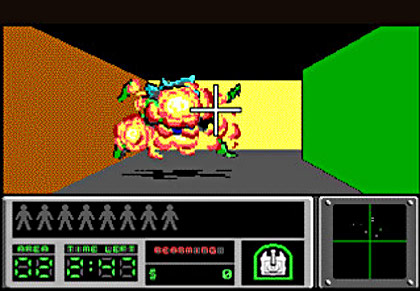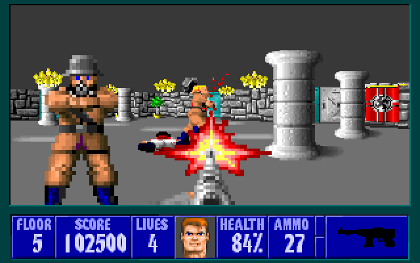
Hovertank 3D. Scalable sprites, big flat vectors. Yum.
But id main man Jon Carmack didn’t really capture mainstream attention until the release of Wolfenstein 3D in the summer of 1992. Inspired by the textured environments present in Looking Glass’ 3D RPG, Ultima Underworld, he set about creating a faster, less demanding ‘ray casting’ technique which could run on relatively low-specced PCs.
Designed by John Romero and Tom Hall, Wolfenstein 3D would prove a watershed moment for the FPS genre. In retrospect, it wasn’t simply the game’s stunning tech which caught the imagination: it was, first and foremost, a hugely enjoyable, fast-paced experience, boasting a truckload of innovative gameplay ideas. Many features we now take for granted, such as weapon selection, health and ammo pick-ups, 360 degree movement, and even the ‘save anywhere’ principle, first saw light in the Wolfenstein 3D template.

Even the Nazi baddies felt original when this was first released.
After almost two decades of experimentation, the first person shooter genre finally had a game worth shouting about.
Key to the rise of the first person shooter was id’s adoption of the ‘shareware’ model, by which gamers got to sample the first 10 levels of Wolfenstein 3D for free. And it was a trick the company repeated with the release of its next title, Doom, at the end of 1993, whose first nine levels were available for free.





 Satoru Iwata Video Interview - the late Nintendo president spoke with Kikizo in 2004 as 'Nintendo Revolution' loomed.
Satoru Iwata Video Interview - the late Nintendo president spoke with Kikizo in 2004 as 'Nintendo Revolution' loomed. Kaz Hirai Video Interview - the first of Kikizo's interviews with the man who went on to become global head of Sony.
Kaz Hirai Video Interview - the first of Kikizo's interviews with the man who went on to become global head of Sony. Ed Fries Video Interview - one of Xbox's founders discusses an epic journey from Excel to Xbox.
Ed Fries Video Interview - one of Xbox's founders discusses an epic journey from Excel to Xbox. Yu Suzuki, the Kikizo Interview - we spend time with one of gaming's most revered creators.
Yu Suzuki, the Kikizo Interview - we spend time with one of gaming's most revered creators. Tetris - The Making of an Icon: Alexey Pajitnov and Henk Rogers reveal the fascinating story behind Tetris
Tetris - The Making of an Icon: Alexey Pajitnov and Henk Rogers reveal the fascinating story behind Tetris Rare founders, Chris and Tim Stamper - their only interview? Genuinely 'rare' sit down with founders of the legendary studio.
Rare founders, Chris and Tim Stamper - their only interview? Genuinely 'rare' sit down with founders of the legendary studio. The History of First-Person Shooters - a retrospective, from Maze War to Modern Warfare
The History of First-Person Shooters - a retrospective, from Maze War to Modern Warfare
[...] Parte 1 (1974-1995) [...]